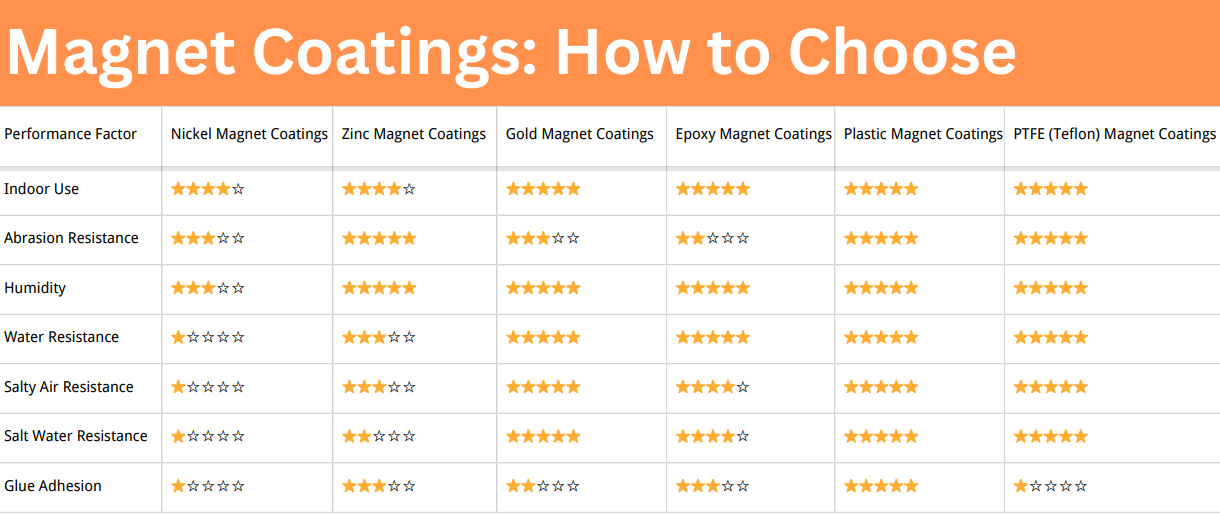All about Halbach Arrays
The Halbach array—now there’s a clever bit of engineering. Strong magnetic force on one side, nearly nothing on the other. It’s no wonder this configuration has caught the attention of researchers, industry folks, and curious minds alike.
Today, let’s take a friendly walk through the key ideas around Halbach arrays. We’ll look at what they are, where they’re used, and why they’re both brilliant and sometimes a bit tricky to work with.
1. Who Invented the Halbach Array?
The Halbach array was invented in the early 1980s by Klaus Halbach, a physicist at Lawrence Berkeley National Laboratory. In his research on particle accelerator designs, he was seeking more efficient ways to channel and focus electron beams using permanent magnets. Doing this, Halbach discovered that by precessing the magnetization direction of a set of neighboring magnets in a specific order, he could produce a strong, localized magnetic field on one side but, practically speaking, eliminate the field on the other.
He formally introduced this innovation in 1985, as a collection of research papers like "Design of Permanent Multipole Magnets with Oriented Rare Earth Cobalt Material," where he spoke about dipole and quadrupole arrangements for application in science.
By the 1990s, engineers began applying Halbach arrays beyond research, primarily to brushless motors, magnetic bearings, and maglev (magnetic levitation) systems. The directional field and small size of the Halbach array benefited these uses. In the 2000s, its use expanded to aerospace and high-speed rail, e.g., maglev trains, where weight, efficiency, and regulated magnetism were critical. More recently, in the 2010s and beyond, Halbach arrays have found their way into robotics, electric cars, drones, and even medical imaging devices, making them perhaps the most widely applicable and far-reaching magnetic technology of the modern age.
Further reading: How Does A Halbach Array Work?
2. How Strong Are Halbach Arrays?
Halbach arrays are special in generating strong, directional magnetic fields—and it does so with fewer magnets. Just consider the test illustrated in the picture below, using a professional Tesla meter.
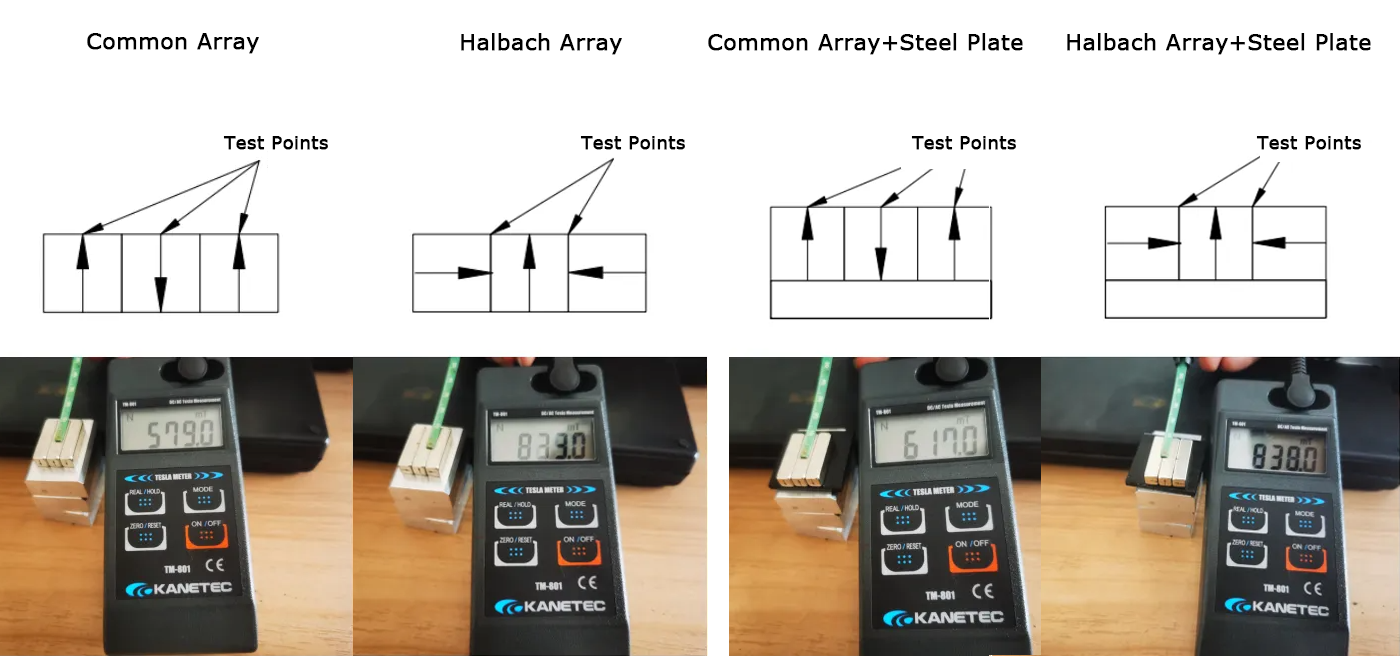
It is visible by comparison. The common array is approximately 579.0 mT. While the Halbach array reaches 833.0 mT—a staggering increase. Even when a steel plate is added, the Halbach array once again does best, with over 830.0 mT.
This illustrates perfectly the general advantage of Halbach arrays: they enhance magnetic strength on one side but almost eradicate it on the other side.
Halbach arrays are also described as follows:
- Even, Smooth Distribution: Next, the field is kept constant and even, especially in circular arrays.
- Single-Sided Focus: Halbach arrays concentrate the field on one side and leave the other side nearly field-free. That's a big win in shielding and levitation.
- Better Space Use: Because the field is so focused, there's less stray flux. That's a win in tight spaces.
- Custom Field Patterns: You can then customize the pattern to form multipole fields. That comes in handy in advanced systems like particle accelerators.
But halbach arrays are not without their limitations. They are problematic to manufacture because the magnets have to be placed in a highly specific manner, which contributes to production costs, especially in larger or more complex shapes. It is also tricky to achieve the correct magnetic direction, and that necessitates specialized equipment. Lastly, high-quality magnets and other magnets to further improve performance contribute to the cost, which makes it less viable and harder to adopt.
3. Linear vs Circular Halbach Array
Linear Halbach Array is a basic arrangement of magnets in a linear array, comprising radial and tangential arrays. It is used mostly in magnetic levitation (maglev) trains, whereby the array is fixed horizontally at the center of the train.
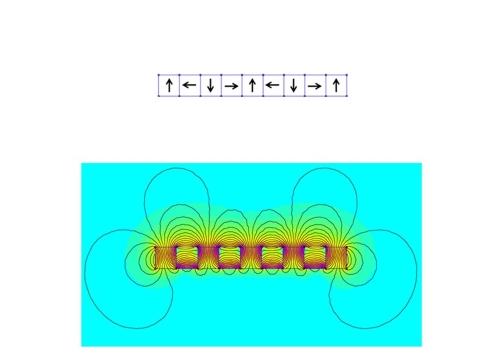
Cylindrical Halbach Array is a cylindrical structure formed by connecting the end of a linear array. It is used in permanent magnet motors, magnetic bearings, and sputtering systems.
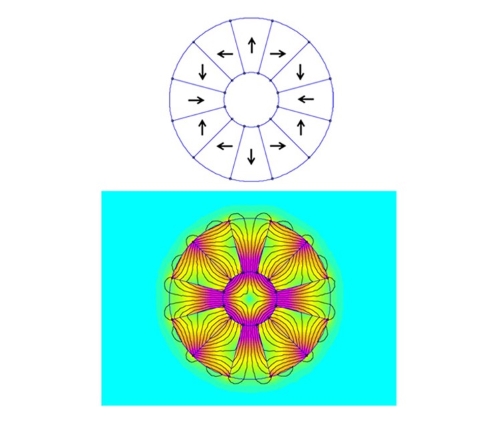
There are also other types of Halbach arrays besides the linear and circular ones. For example, a planar Halbach array is flat and two-dimensional. It's often used in small devices where a special magnetic field is needed. Then there's the spherical Halbach array, where magnets are arranged in a ball shape. This type is used in things like particle accelerators and some MRI machines, because it gives an even magnetic field in all directions. Lastly, the toroidal Halbach array has a donut-like shape and is used in fusion reactors or scientific tools to create a ring-shaped magnetic field.
4. What Is A Halbach Array Used For?
A Halbach array is useful in several fields. For example, in maglev trains like Japan’s SCMaglev, Halbach arrays help lift and move the train without contact. In MRI machines, they create strong and uniform magnetic fields that improve image quality. In electric motors, such as those in drones or compact robots, Halbach arrays increase efficiency and power by concentrating the magnetic field where it’s most effective.

In industry, it's used in maglev conveyor systems to lift and move objects with less energy loss and wear. In electric motors, it finds uses in some high-end drone motors. Thus, it boosts efficiency and power density. In medicine, Halbach arrays are used in MRI machines. They are also ideal for magnetic therapy and drug delivery. In scientific research, they are used in particle accelerators and fusion research. They are also used in advanced fields such as quantum computing and communication.
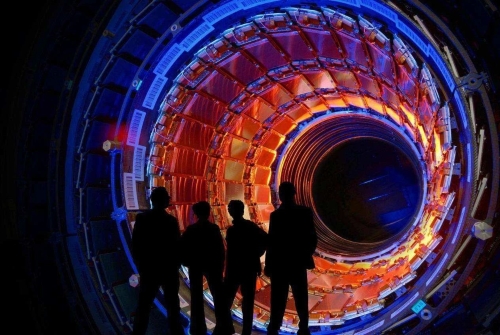
Summary
The Halbach array is a clever magnetic arrangement that focuses the magnetic field on one side while canceling it on the other. It’s not just a neat trick with magnets—it’s a tool that keeps finding new uses, from trains to hospitals to the labs. For more information and technical support, please check Stanford Magnets.












